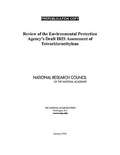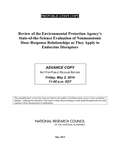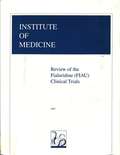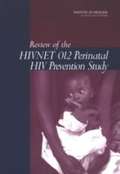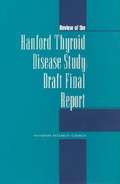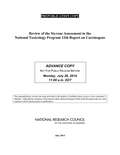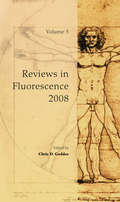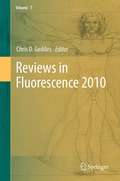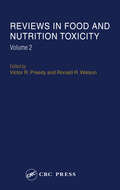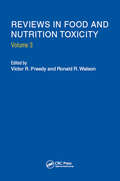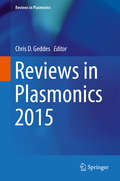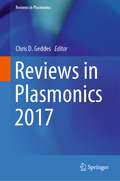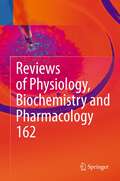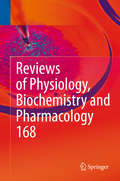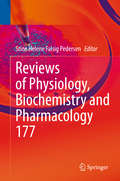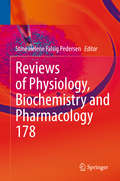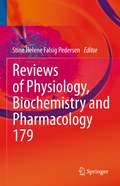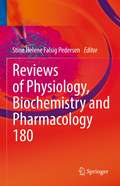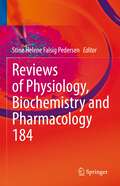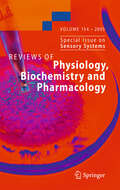- Table View
- List View
Review of the Environmental Protection Agency's Draft IRIS Assessment of Tetrachloroethylene
by National Research Council of the National AcademiesTetrachloroethylene is a volatile, chlorinated organic hydrocarbon that is widely used as a solvent in the dry-cleaning and textile-processing industries and as an agent for degreasing metal parts. It is an environmental contaminant that has been detected in the air, groundwater, surface waters, and soil. In June 2008, the U.S. Environmental Protection Agency released its draft Toxicological Review of Tetrachloroethylene (Perchloroethylene) (CAS No. 127-18-4) in Support of Summary Information on the Integrated Risk Information System (IRIS). The draft IRIS assessment provides quantitative estimates of cancer and noncancer effects of exposure to tetrachloreothylene, which will be used to establish airquality and water-quality standards to protect public health and to set cleanup standards for hazardous waste sites. At the request of EPA, the National Research Council conducted an independent scientific review of the draft IRIS assessment of tetrachloroethylene from toxicologic, epidemiologic, and human clinical perspectives. The resulting book evaluates the adequacy of the EPA assessment, the data and methods used for deriving the noncancer values for inhalation and oral exposures and the oral and inhalation cancer unit risks posed by tetrachloroethylene; evaluates whether the key studies underlying the draft IRIS assessment are of requisite quality, reliability, and relevance to support the derivation of the reference values and cancer risks; evaluates whether the uncertainties in EPA's risk assessment were adequately described and, where possible, quantified; and identifies research that could reduce the uncertainty in the current understanding of human health effects associated with tetrachloroethylene exposure.
Review of the Environmental Protection Agency's State-of-the-Science Evaluation of Nonmonotonic Dose-Response Relationships as they Apply to Endocrine Disruptors
by National Research Council of the National AcademiesPotential health effects of chemicals that disrupt endocrine function pose an environmental health concern about their ability to interfere with normal hormone function in human and wildlife populations. The endocrine system regulates biologic processes throughout the body and can be sensitive to small changes in hormone concentrations. Endocrine-disruptor research has focused primarily on chemicals that affect three hormone pathways that play important roles in reproduction and development—the estrogen, androgen, and thyroid hormone pathways. Some of the research has identified dose–response relationships that have nonmonotonic curves. Nonmonotonic dose–response (NMDR) curves are of concern because they do not follow the usual assumption made in toxicology that toxic response decreases as dose decreases. The slope of a NMDR curve changes sign, and the function can take on the shape of a U, the shape of an inverted U, or another shape that has more than one inflection point. <P> The existence of NMDR curves has been controversial for decades, and there has been considerable debate about their implications for the testing of chemicals and the assessment of risks posed by chemicals. Toxicity tests are designed to identify hazards and to characterize dose–response relationships, so they are aimed at finding a dose that is high enough to elicit a response and exploring dose–response relationships by spacing lower doses to identify a no-observed-adverse-effect level (NOAEL) or a lowest observed-adverse-effect level. One concern raised by NMDR relationships is that such studies as currently designed might not detect critical points (such as peaks and valleys) along a dose–response curve if only a few doses are tested or if the inflection point occurs below the doses tested. Another concern is that some NMDR relationships are found in connection with biologic effects that are not usually evaluated in toxicity tests. If current testing strategies are inadequate to account for NMDR relationships, changes in risk-assessment practices might be necessary.
Review of the Fialuridine (FIAU) Clinical Trials
by Committee to Review the Fialuridine (FIAU/FIAC) Clinical TrialsIn June 1993 a clinical trial of fialuridine (FIAU), a promising new medication for hepatitis B, was abruptly terminated when one of the 15 out-patients participating in the National Institutes of Health (NIH) study was suddenly hospitalized with liver failure. Although all the remaining patients were contacted and told to stop taking their medication, six more subsequently developed severe toxicity. Five patients died, and two others were probably saved from death only by having liver transplants. In response to a request from the Secretary of the Department of Health and Human Services, the IOM committee has analyzed the FIAU clinical trials, making recommendations for additional safeguards for the conduct of future clinical trials. This evaluation included the review of documents pertaining to investigational new drug submissions, protocols and consent forms from other clinical trials, as well as information available from other clinical and preclinical experience with compounds related to FIAU and its parent drug, fiacitibine (FIAC), which is metabolized to FIAU. The committee does not seek to affix responsibility for the adverse outcome of this NIH trial, but instead focuses on whether any rules or procedures governing the clinical trials process itself need to be changed, and if so, what burdens or costs such changes might place on future clinical trials.
Review of the Formaldehyde Assessment in the National Toxicology Program 12th Report on Carcinogens
by Committee to Review the Formaldehyde Assessment in the National Toxicology Program 12th Report on CarcinogensMany people in the United States are exposed to formaldehyde. Exposure can occur from environmental sources (for example, combustion processes, building materials, and tobacco smoke) or in occupational settings (for example, the furniture, textile, and construction industries). Formaldehyde exposure also has endogenous sources--it is produced intracellularly as a component of the one carbon pool intermediary metabolism pathway. Scientists have studied formaldehyde for decades to determine whether exogenous formaldehyde exposure may be associated with cancer in humans. In 1981, The National Toxicology Program (NTP) first listed formaldehyde in the 2nd Report on Carcinogens as "reasonably anticipated to be a human carcinogen. " In 2011, NTP upgraded the listing of formaldehyde to "known to be a human carcinogen. " Following the new listing, Congress directed the Department of Health and Human Services to arrange for the National Academy of Sciences to independently review formaldehyde's substance profile and listing. This report presents the findings and conclusions of the committee formed in response to the congressional request. "Review of the Formaldehyde Assessment in the National Toxicology Program 12th Report on Carcinogens" concurs with NTP that there is sufficient evidence in studies that had adequate characterization of relevant exposure metrics to enable a strong conclusion about the association between formaldehyde exposure and cancer in humans. Additionally, the authoring committee independently reviewed the scientific evidence from studies in humans, experimental animals, and other studies relevant to the mechanisms of carcinogenesis and made level-of-evidence conclusions. This report finds clear and convincing epidemiologic evidence of an association between formaldehyde exposure and nasopharyngeal and sinonasal cancers in humans.
Review of the HIVNET 012 Perinatal HIV Prevention Study
by Institute of Medicine of the National AcademiesThe National Academies Press (NAP)--publisher for the National Academies--publishes more than 200 books a year offering the most authoritative views, definitive information, and groundbreaking recommendations on a wide range of topics in science, engineering, and health. Our books are unique in that they are authored by the nation's leading experts in every scientific field.
Review of the Hanford Thyroid Disease Study Draft Final Report
by National Research CouncilA Review of the Hanford Thyroid Disease Study Draft Final Report
Review of the Styrene Assessment in the National Toxicology Program 12th Report on Carcinogens
by Committee to Review the Styrene Assessment in the National Toxicology Program 12th Report on CarcinogensMany people in the United States are exposed to styrene. Sources of environmental exposure included food (from migration of styrene from polymer packaging materials), cigarette smoke, vehicle exhaust and other forms of combustion and incineration of styrene polymers. Occupational exposure to humans can occur during the industrial processing of styrene. It is used to create a broad spectrum of products, including latex paints and coatings; synthetic rubbers; construction materials, such as pipes, fittings, and lighting fixtures; packaging; household goods, such as synthetic marble, flooring, and molded furnishings; and automotive parts. In 2011, the National Toxicology Program (NTP) listed styrene as "reasonably anticipated to be a human carcinogen" in its 12th Report on Carcinogens, marking the first time that the substance was listed. Congress directed the Department of Health and Human Services to arrange for the National Academy of Sciences to independently review the substance profile of styrene and it listing in the NTP report. "Review of the Styrene Assessment in the National Toxicology Program 12th Report on Carcinogens" concurs with the NTP determination that there is limited but credible evidence that exposure to styrene in some occupational settings is associated with an increase in the frequency of lymphohematopoietic cancers. Additionally, the NRC report authoring committee independently reviewed the scientific evidence from studies in humans, experimental animals, and other studies relevant to the mechanisms of carcinogenesis and made level-of-evidence conclusions. Based on credible but limited evidence of carcinogenicity in traditional epidemiologic studies, on sufficient evidence of carcinogenicity in animals, and on convincing evidence that styrene is genotoxic in exposed humans, this report finds that compelling evidence exists to support a listing of styrene as, at a minimum, "reasonably anticipated to be a human carcinogen. "
Reviews in Fluorescence 2008
by Chris D. GeddesThis is the fifth volume in the Reviews in Fluorescence series. To date, four volumes have been both published and well received by the scientific community. Several book reviews in the last few years have also favourably remarked on the series. In this 5th volume we continue the tradition of publishing leading edge and timely articles from authors around the world. We thank the authors for their timely and exciting contributions. We hope you will find this volume as useful as past volumes, which promises to be just as diverse with regard to fluorescence-based content.
Reviews in Fluorescence 2010
by Chris D. GeddesReviews in Fluorescence 2010, the seventh volume of the book serial from Springer, serves as a comprehensive collection of current trends and emerging hot topics in the field of fluorescence and closely related disciplines. It summarizes the year’s progress in fluorescence and its applications, with authoritative analytical reviews specialized enough to be attractive to professional researchers, yet also appealing to the wider audience of scientists in related disciplines of fluorescence. Reviews in Fluorescence offers an essential reference material for any lab working in the fluorescence field and related areas. All academics, bench scientists, and industry professionals wishing to take advantage of the latest and greatest in the continuously emerging field of fluorescence will find it an invaluable resource. Key features: Accessible utility in a single volume reference. chapters authored by known leading figures in the fluorescence field, new volume publishes annually, comprehensive coverage of the year's hottest and emerging topics, each Reviews in Fluorescence volume is citable (ISI) and indexed. Reviews in Fluorescence 2010 topics include: Novel Metal-based Luminophores for Biological Imaging. hydration Dynamics of Probes and Peptides in Captivity, how does tobacco etch viral mRNA get translated? A fluorescence study of competition, stability and kinetics, synchronous Fluorescence Spectroscopy and Its Applications in Clinical Analysis and Food Safety Evaluation, quantitative molecular imaging in living cells via FLIM, a Multiparametric Imaging of Cellular Coenzymes for Monitoring Metabolic and Mitochondrial Activities, optimal Conditions for Live Cell Microscopy and Raster Image Correlation Spectroscopy (RICS).
Reviews in Food and Nutrition Toxicity
by Victor R. Preedy Ronald R. WatsonFoot and mouth disease, CJD, GM, and fears about modern methods of food production have put food safety in the spotlight. In addition, the food industry is increasingly reliant upon technological innovation, requiring anyone connected with food safety to keep abreast of the key issues and advances. Reviews in Food and Nutrition Toxicity, Vo
Reviews in Food and Nutrition Toxicity, Volume 2
by Victor R. Preedy Ronald R. WatsonThis second volume of Reviews in Food and Nutrition Toxicity follows on directly from the successes of the first volume published last year. This series disseminates important data pertaining to food and nutrition safety and toxicology that is relevant to humans. Chapters in this series extend from the introduction of toxins in the manufacture or p
Reviews in Food and Nutrition Toxicity, Volume 3
by Victor R. PreedyIncluding the latest reviews of the most current issues related to food and nutrition toxicity, Reviews in Food and Nutrition Toxicity, Volume 3 distills a wide range of research on food safety and food technology. Put together by a strong team with a wealth of broad experience, the continuation of this important new series includes contributions f
Reviews in Food and Nutrition Toxicity, Volume 4
by Victor R. Preedy Ronald Ross WatsonReviews in Food and Nutrition Toxicity, Volume 4 includes the most recent reviews of current issues involved in the toxicity of food and nutrients. With contributors from the fields of medicine, public health, and environmental science, the continuation of this series distills a broad range of research on food safety and food technology. Vo
Reviews in Plasmonics 2010
by Chris D. GeddesReviews in Plasmonics 2010, the first volume of the new book serial from Springer, serves as a comprehensive collection of current trends and emerging hot topics in the field of Plasmonics and closely related disciplines. It summarizes the year's progress in surface plasmon phenomena and its applications, with authoritative analytical reviews specialized enough to be attractive to professional researchers, yet also appealing to the wider audience of scientists in related disciplines of Plasmonics. Reviews in Plasmonics offers an essential reference material for any lab working in the Plasmonics field and related areas. All academics, bench scientists, and industry professionals wishing to take advantage of the latest and greatest in the continuously emerging field of Plasmonics will find it an invaluable resource. Key features: Accessible utility in a single volume reference. Chapters authored by known leading figures in the Plasmonics field.New volume publishes annually.Comprehensive coverage of the year's hottest and emerging topics. Reviews in Plasmonics 2011 topics include: Metal Nanoparticles for Molecular Plasmonics. Surface Plasmon Resonance based Fiber Optic Sensors.Elastic Light Scattering of Biopolymer/Gold Nanoparticles Fractal Aggregates. Influence of electron quantum confinement on the electronic response of metal/metal interfaces.Melting Transitions of DNA-Capped Gold Nanoparticle Assemblies.Nanomaterial Based Long Range Optical Ruler for Monitoring Biomolecular Activities. Plasmonic Gold and Silver Films: Selective Enhancement of Chromophore Raman Scattering or Plasmon-Assisted Fluorescence.
Reviews in Plasmonics 2017 (Reviews in Plasmonics #2017)
by Chris D. GeddesReviews in Plasmonics is a comprehensive collection of current trends and emerging hot topics in the field of Plasmonics and closely related disciplines. It summarizes the years progress in Plasmonics and its applications, with authoritative analytical reviews specialized enough to be attractive to professional researchers, yet also appealing to the wider audience of scientists in related disciplines of Plasmonics.
Reviews of Environmental Contamination and Toxicology Volume 245: Perfluorinated Alkylated Substances (Reviews of Environmental Contamination and Toxicology #245)
by Pim De VoogtReviews of Environmental Contamination and Toxicology attempts to provide concise, critical reviews of timely advances, philosophy and significant areas of accomplished or needed endeavor in the total field of xenobiotics, in any segment of the environment, as well as toxicological implications.
Reviews of Environmental Contamination and Toxicology volume 230: With Cumulative and Comprehensive Index Subjects Covered Volumes 221-230
by David M. WhitacreReviews of Environmental Contamination and Toxicology attempts to provide concise, critical reviews of timely advances, philosophy and significant areas of accomplished or needed endeavor in the total field of xenobiotics, in any segment of the environment, as well as toxicological implications.
Reviews of Physiology, Biochemistry and Pharmacology
by Ole H. Petersen Bernd Nilius Reinhard Jahn Stefan Offermanns Roland Lill Susan G. Amara Thomas GudermannCardiac ion channels and mechanisms for protection against atrial fibrillation. Intrinsically photosensitive retinal ganglion cells. Quantifying and modeling the temperature-dependent gating of TRP channels.
Reviews of Physiology, Biochemistry and Pharmacology
by Ole H. Petersen Bernd Nilius Reinhard Jahn Roland Lill Thomas Gudermann Pieter P. de TombeLeading researchers are specially invited to provide a complete understanding of the key topics in these archetypal multidisciplinary fields. In a form immediately useful to scientists, this periodical aims to filter, highlight and review the latest developments in these rapidly advancing fields.
Reviews of Physiology, Biochemistry and Pharmacology (Reviews of Physiology, Biochemistry and Pharmacology #177)
by Stine Helene Falsig PedersenLeading researchers are specially invited to provide a complete understanding of a key topic within the multidisciplinary fields of physiology, biochemistry and pharmacology. In a form immediately useful to scientists, this periodical aims to filter, highlight and review the latest developments in these rapidly advancing fields.Chapter “Stationary and Non-Stationary Ion- and Water Flux Interactions in Kidney Proximal Tubule. Mathematical Analysis of Isosmotic Transport by a Minimalistic Model“ is available open access under a Creative Commons Attribution 4.0 International License via link.springer.com.
Reviews of Physiology, Biochemistry and Pharmacology (Reviews of Physiology, Biochemistry and Pharmacology #178)
by Stine Helene Falsig PedersenLeading researchers are specially invited to provide a complete understanding of a key topic within the multidisciplinary fields of physiology, biochemistry and pharmacology. In a form immediately useful to scientists, this periodical aims to filter, highlight and review the latest developments in these rapidly advancing fields.
Reviews of Physiology, Biochemistry and Pharmacology (Reviews of Physiology, Biochemistry and Pharmacology #179)
by Stine Helene Falsig PedersenLeading researchers are specially invited to provide a complete understanding of a key topic within the multidisciplinary fields of physiology, biochemistry and pharmacology. In a form immediately useful to scientists, this periodical aims to filter, highlight and review the latest developments in these rapidly advancing fields.
Reviews of Physiology, Biochemistry and Pharmacology (Reviews of Physiology, Biochemistry and Pharmacology #180)
by Stine Helene Falsig PedersenLeading researchers are specially invited to provide a complete understanding of a key topic within the multidisciplinary fields of physiology, biochemistry and pharmacology. In a form immediately useful to scientists, this periodical aims to filter, highlight and review the latest developments in these rapidly advancing fields.
Reviews of Physiology, Biochemistry and Pharmacology (Reviews of Physiology, Biochemistry and Pharmacology #184)
by Stine Helene Falsig PedersenLeading researchers are specially invited to provide a complete understanding of a key topic within the multidisciplinary fields of physiology, biochemistry and pharmacology. In a form immediately useful to scientists, this periodical aims to filter, highlight and review the latest developments in these rapidly advancing fields.
Reviews of Physiology, Biochemistry and Pharmacology 154
by S. OffermannsThis volume presents a neural network architecture for the prediction of conditional probability densities - which is vital when carrying out universal approximation on variables which are either strongly skewed or multimodal. Two alternative approaches are discussed: the GM network, in which all parameters are adapted in the training scheme, and the GM-RVFL model which draws on the random functional link net approach. Points of particular interest are: - it examines the modification to standard approaches needed for conditional probability prediction; - it provides the first real-world test results for recent theoretical findings about the relationship between generalisation performance of committees and the over-flexibility of their members; This volume will be of interest to all researchers, practitioners and postgraduate / advanced undergraduate students working on applications of neural networks - especially those related to finance and pattern recognition.
